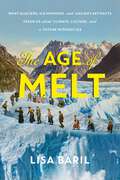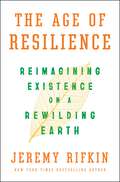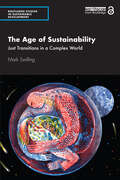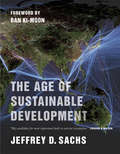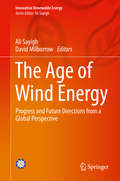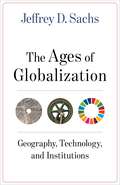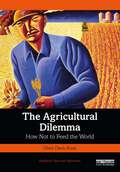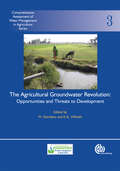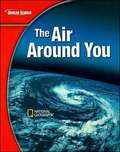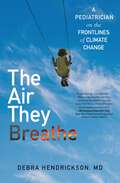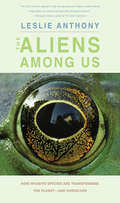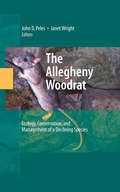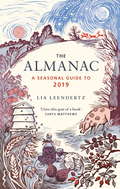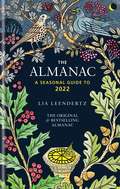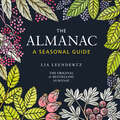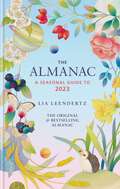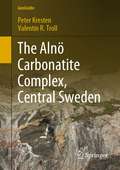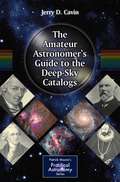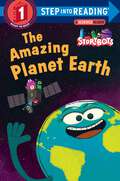- Table View
- List View
The Age of Melt: What Glaciers, Ice Mummies, and Ancient Artifacts Teach Us about Climate, Culture, and a Future without Ice
by Lisa BarilA thought-provoking scientific narrative investigating ice patch archaeology and the role of glaciers in the development of human culture. Glaciers figure prominently in both ancient and contemporary narratives around the world. They inspire art and literature. They spark both fear and awe. And they give and take life. In The Age of Melt, environmental journalist Lisa Baril explores the deep-rooted cultural connection between humans and ice through time. Thousands of organic artifacts are emerging from patches of melting ice in mountain ranges around the world. Archaeologists are in a race against time to find them before they disappear forever. In entertaining and enlightening prose, Baril travels from the Alps to the Andes, investigating what these artifacts teach us about climate and culture. But this is not a chronicle of loss. The Age of Melt explores what these artifacts reveal about culture, wilderness, and what we gain when we rethink our relationship to the world and its most precious and ephemeral substance—ice.
The Age of Resilience: Reimagining Existence on a Rewilding Earth
by Jeremy RifkinA sweeping new interpretation of the history of civilization and a transformative vision of how our species will thrive on an unpredictable Earth.The viruses keep coming, the climate is warming, and the Earth is rewilding. Our human family has no playbook to address the mayhem unfolding around us. If there is a change to reckon with, argues the renowned economic and social theorist Jeremy Rifkin, it’s that we are beginning to realize that the human race never had dominion over the Earth and that nature is far more formidable than we thought, while our species seems much smaller and less significant in the bigger picture of life on Earth, undermining our long-cherished worldview. The Age of Progress, once considered sacrosanct, is on a deathwatch while a powerful new narrative, the Age of Resilience, is ascending.In The Age of Resilience, Rifkin takes us on a new journey beginning with how we reconceptualize time and navigate space. During the Age of Progress, efficiency was the gold standard for organizing time, locking our species into the quest to optimize the expropriation, commodification, and consumption of the Earth’s bounty, at ever-greater speeds and in ever-shrinking time intervals, with the objective of increasing the opulence of human society, but at the expense of the depletion of nature. Space, observes Rifkin, became synonymous with passive natural resources, while a principal role of government and the economy was to manage nature as property. This long adhered to temporal-spatial orientation, writes Rifkin, has taken humanity to the commanding heights as the dominant species on Earth and to the ruin of the natural world.In the emerging era, says Rifkin, efficiency is giving way to adaptivity as the all-encompassing temporal value while space is perceived as animated, self-organizing, and fluid. A younger generation, in turn, is pivoting from growth to flourishing, finance capital to ecological capital, productivity to regenerativity, Gross Domestic Product to Quality of Life Indicators, hyper-consumption to eco-stewardship, globalization to glocalization, geopolitics to biosphere politics, nation-state sovereignty to bioregional governance, and representative democracy to citizen assemblies and distributed peerocracy.Future generations, suggests Rifkin, will likely experience existence less as objects and structures and more as patterns and processes and come to understand that each of us is literally an ecosystem made up of the microorganisms and elements that comprise the hydrosphere, lithosphere, atmosphere, and biosphere. The autonomous self of the Age of Progress is giving way to the ecological self of the Age of Resilience. The now worn scientific method that underwrote the Age of Progress is also falling by the wayside, making room for a new approach to science called Complex Adaptive Systems modeling. Likewise, detached reason is losing cachet while empathy and biophilia become the norm.At a moment when the human family is deeply despairing of the future, Rifkin gives us a window into a promising new world and a radically different future that can bring us back into nature’s fold, giving life a second chance to flourish on Earth.
The Age of Sustainability: Just Transitions in a Complex World (Routledge Studies in Sustainable Development)
by Mark SwillingWith transitions to more sustainable ways of living already underway, this book examines how we understand the underlying dynamics of the transitions that are unfolding. Without this understanding, we enter the future in a state of informed bewilderment. Every day we are bombarded by reports about ecosystem breakdown, social conflict, economic stagnation and a crisis of identity. There is mounting evidence that deeper transitions are underway that suggest we may be entering another period of great transformation equal in significance to the agricultural revolution some 13,000 years ago or the Industrial Revolution 250 years ago. This book helps readers make sense of our global crisis and the dynamics of transition that could result in a shift from the industrial epoch that we live in now to a more sustainable and equitable age. The global renewable energy transition that is already underway holds the key to the wider just transition. However, the evolutionary potential of the present also manifests in the mushrooming of ecocultures, new urban visions, sustainability-oriented developmental states and new ways of learning and researching. Shedding light on the highly complex challenge of a sustainable and just transition, this book is essential reading for anyone concerned with establishing a more sustainable and equitable world. Ultimately, this is a book about hope but without easy answers.
The Age of Sustainable Development
by Sachs Jeffrey D.A bold and engaging intellectual synthesis on how modern societies can develop economically, equitably, and sustainably while preserving Earth's ecosystems and biodiversity.
The Age of Sustainable Development
by Jeffrey D. SachsJeffrey D. Sachs has shown himself to be one of the world's most perceptive and original analysts of global development in his groundbreaking books, including The End of Poverty and Common Wealth: Economics for a Crowded Planet. Now, in this major new work he presents a compelling and practical framework for how global citizens can address the seemingly intractable worldwide problems of persistent extreme poverty, environmental degradation, and political-economic injustice. Sachs outlines the holistic way forward: sustainable development. This provocative work offers readers, students, activists, environmentalists, and policy makers the tools, metrics, and practical pathways they need to achieve Sustainable Development Goals. Far more than a rhetorical exercise, this book is designed to inform, inspire, and spur action. Based on Sachs's twelve years as director of the Earth Institute at Columbia University, his thirteen years advising the United Nations secretary-general on the Millennium Development Goals, and his recent presentation of these ideas in a popular online course, The Age of Sustainable Development is a landmark publication and a clarion call for all who care about our planet and global justice.
The Age of Sustainable Development
by Jeffrey D. SachsJeffrey D. Sachs is one of the world's most perceptive and original analysts of global development. In this major new work he presents a compelling and practical framework for how global citizens can use a holistic way forward to address the seemingly intractable worldwide problems of persistent extreme poverty, environmental degradation, and political-economic injustice: sustainable development. <P><P>Sachs offers readers, students, activists, environmentalists, and policy makers the tools, metrics, and practical pathways they need to achieve Sustainable Development Goals. Far more than a rhetorical exercise, this book is designed to inform, inspire, and spur action. Based on Sachs's twelve years as director of the Earth Institute at Columbia University, his thirteen years advising the United Nations secretary-general on the Millennium Development Goals, and his recent presentation of these ideas in a popular online course, The Age of Sustainable Development is a landmark publication and clarion call for all who care about our planet and global justice.
The Age of Wind Energy: Progress and Future Directions from a Global Perspective (Innovative Renewable Energy)
by Ali Sayigh David MilborrowThis unique volume on wind energy features contributions from the world’s leading research and development pioneers in the field of renewable energy. It discusses advances in offshore wind technology, grid-connected systems, grid stabilization and wind turbine design and highlights. Written from an international perspective, chapters focus on the status of wind energy in various regions and countries across the globe, outlining the positive impact its implementation has had on delaying the catastrophic effects of climate change.
The Ages of Globalization: Geography, Technology, and Institutions
by Jeffrey D. SachsToday’s most urgent problems are fundamentally global. They require nothing less than concerted, planetwide action if we are to secure a long-term future. But humanity’s story has always been on a global scale. In this book, Jeffrey D. Sachs, renowned economist and expert on sustainable development, turns to world history to shed light on how we can meet the challenges and opportunities of the twenty-first century. <P><P>Sachs takes readers through a series of seven distinct waves of technological and institutional change, starting with the original settling of the planet by early modern humans through long-distance migration and ending with reflections on today’s globalization. Along the way, he considers how the interplay of geography, technology, and institutions influenced the Neolithic revolution; the role of the horse in the emergence of empires; the spread of large land-based empires in the classical age; the rise of global empires after the opening of sea routes from Europe to Asia and the Americas; and the industrial age. The dynamics of these past waves, Sachs demonstrates, offer fresh perspective on the ongoing processes taking place in our own time—a globalization based on digital technologies. Sachs emphasizes the need for new methods of international governance and cooperation to prevent conflicts and to achieve economic, social, and environmental objectives aligned with sustainable development. The Ages of Globalization is a vital book for all readers aiming to make sense of our rapidly changing world.
The Agricultural Dilemma: How Not to Feed the World (Earthscan Food and Agriculture)
by Glenn Davis StoneThe Agricultural Dilemma questions everything we think we know about the current state of agriculture and how to, or perhaps more importantly how not to, feed a world with a growing population. This book is about the three fundamental forms of agriculture: Malthusian (expansion), industrialization (external-input-dependent), and intensification (labor-based). The best way to understand the three agricultures, and how we tend to get it wrong, is to consider what drives their growth. The book provides a thoughtful, critical analysis that upends entrenched misconceptions such as that we are running out of land for food production and that our only hope is the development of new agricultural technologies. The book contains engaging and enlightening vignettes and short histories, with case studies drawn from across the globe to bring to life this important debate and dilemma. The book concludes by arguing there is a viable alternative to industrial agriculture which will allow us to meet the world's needs and it ponders why such alternatives have been downplayed, obscured, or hidden from view. This important book is essential reading for all studying and researching food production and agriculture, and more broadly for all interested in ensuring we are able to feed our growing population.
The Agricultural Groundwater Revolution: Opportunities and Threats to Development
by Mark Giordano Karen G. VillholthWhile addressing the issues of using groundwater in agriculture for irrigation in the developing world, this book discusses the problems associated with the degradation and over-exploitation of using it. It explores the practiced and potential methods for its management in the context of agricultural development.
The Air Around You
by Glencoe Mcgraw-HillDiscover the Flexibility to Teach Science Your Way!. "Glencoe Science: The Air Around You," a module in the Glencoe Science 15 book series, provides students with accurate and comprehensive coverage of middle school National Science Education Standards. Concepts are explained in a clear, concise manner, and are integrated with a wide range of hands-on experiences, critical thinking opportunities, real-world applications, and connections to other sciences and to non-science areas of the curriculum. Co-authored by National Geographic, unparalleled graphics reinforce key concepts. A broad array of print and technology resources help differentiate and accommodate all learners. The modular approach allows you to mix and match books to meet your specific curriculum needs.
The Air They Breathe: A Pediatrician on the Frontlines of Climate Change
by Debra HendricksonA timely, revelatory first look into the impact climate change has on children—the greatest moral crisis humanity faces today—by a pediatrician in the fastest warming city in America.Wildfires, hurricanes, and heat waves make headlines. But what is happening in Debra Hendrickson&’s clinic tells another story of this strange and unsettling time. Hendrickson is a pediatrician in Reno, Nevada—the fastest warming city in the United States, where ash falls like snow during summer wildfires. In The Air They Breathe, Dr. Hendrickson recounts patients she&’s seen who were harmed by worsening smoke, smog, and pollen; two boys in Arizona, stricken by record-setting heat while hiking; children who fled for their lives from Hurricane Harvey and the Tubbs Fire; and a little girl whose life was forever altered by the Zika virus outbreak in 2016. The climate crisis is a health crisis, and it is a health crisis, first and foremost, for children. Children&’s bodies are interwoven with and shaped by their surroundings. As the planet warms and their environment changes, children&’s health is at risk. The youngest are especially vulnerable because their brain, lungs, and other organs are forming and growing every day, and because their physiology is so different from that of adults. Childhood has always been a risky period of life; throughout history, babies and children have met peril, from polio to famine, from cyclones to war. Yet they have never quite had to face, in quite this way, the potential loss of the future itself. The Air They Breathe is not just about the health impacts of global warming, but something more: a soul-stirring reminder of our moral responsibility to our children, and their profound connections to this unique and irreplaceable world.
The Aliens Among Us: How Invasive Species Are Transforming the Planet—and Ourselves
by Leslie AnthonyA thoughtful, accessible look at the rapidly growing issue of invasive plants, animals, and microbes around the globe with a focus on the scientific issues and ecological, health, and other challenges From an award-winning adventure and science journalist comes an eye-opening exploration of a burgeoning environmental phenomenon and the science coalescing around it. Leslie Anthony leads readers on adventures physical and philosophical as he explores how and why invasive species are hijacking ecosystems around the globe. Weaving science, travel, history, and humor with diverse examples to chart and describe the phases of species invasion and human response, Anthony introduces field researchers and managers who seek to understand the biological, social, and economic aspects of this complex issue, and whose work collectively suggests the emergence of a global shadow economy centered on invasives. With tales of pythons in the Everglades, Asian carp and lamprey in the Great Lakes, Japanese knotweed seemingly everywhere, and the invasive organisms we don’t see—pathogens and microbes such as the Zika virus—this book rivets attention on a new ecological reality.
The Allegheny Woodrat
by John Peles Janet WrightA decline in populations of Allegheny woodrats (Neotoma magister) was first noticed in the 1980s. Since that time, woodrats have become extirpated from at least two states and have declined dramatically in several others. Recent evidence suggests that the decline of this species may be proceeding further south to include states where woodrat populations were previously considered to be stable. The Allegheny Woodrat: Ecology, Conservation, and Management of a Declining Species provides a comprehensive summary of research conducted over the past twenty-five years. The book integrates the results of this research into a comprehensive picture of the ecological requirements, conservation principles, and management strategies for this declining species. In addition, general principles learned from the study of woodrats are applied to the conservation and management of other declining species, including other species of Neotoma. The editors and chapter authors are researchers from both academic settings and state management agencies, individuals who have contributed significantly to the study of Allegheny woodrats during the past two decades. The book will be of interest to ecologists, conservation biologists, wildlife professionals, and students.
The Allocation of Regulatory Competence in the EU Emissions Trading Scheme
by Josephine Van ZebenThe European Union's Emissions Trading System (EU ETS) is the world's largest carbon trading market. This book offers a new perspective on the EU ETS as a multi-level governance regime, in which the regulatory process is composed of three distinct 'competences' - norm setting, implementation, and enforcement. Are these competences best combined in a single regulator at one level of government or would they be better allocated among a variety of regulators at different levels of government? The combined legal, economic, and political analysis in this book reveals that the actual allocation of competences within the EU ETS diverges from a hypothetical ideal allocation in important ways, and provides a political economy explanation for the existing allocation of norm setting, implementation and enforcement competences among various levels of European government.
The Almanac: A Seasonal Guide to 2019
by Lia LeendertzTHE ORIGINAL & BESTSELLING ALMANAC 'I love this gem of a book' - Cerys Matthews 'This book is your bible' - The Independent '...it already feels like an annual necessity' - India Knight'Joyous' - Allan Jenkins'Updated for 2019 with more lovely ideas to celebrate the seasons' - Gardens Illustrated'A charming book. This is a real gem of a gift' - Sunday Express, S Magazine. A perfect toolkit connecting with the world around us and the year ahead as it unfolds - all in a compact and pocket size that just begs you to pick it up and browse - Reckless Gardener or Its range of information and depth of understanding of our seasons is priceless - Reckless GardenerThe Almanac: A Seasonal Guide to 2019 reinvents the tradition of the rural almanac for a new audience. It gives you the tools and inspiration you need to celebrate, mark and appreciate each month of the year in your own particular way. Divided into the 12 months, a set of tables each month gives it the feel and weight of a traditional almanac, providing practical information that gives access to the outdoors and the seasons, perfect for expeditions, meteor-spotting nights and beach holidays. There are also features on each month's unique nature, such as the meteor shower of the month, beehive behaviour, folklore and stories, seasonal recipes and charts tracking moon phases and tides. Why not try identifying trees by their bare buds in January; Enjoy Buttermilk scones with orangle blossom & honey butter in June; Discover the Chinese New Year story of 'The great race' in February.You will find yourself referring to the almanac all year long, revisiting it again and again, and looking forward to the next edition as the year draws to a close.Praise for The Almanac: A Seasonal Guide to 2018:'The perfect companion to the seasons' - India Knight'A richly layered book of events, celebrations and everyday information that together create a beautiful, fascinating resource . . . In the single month I've had my hands on it, the book has quietly "worked".' - Telegraph'Beautifully written, this pocket-sized guide is a labour of love and will remind you to appreciate little moments throughout the year.' - Gardens Illustrated'Elegant . . . an ideal stocking filler.' - The English Garden
The Almanac: A Seasonal Guide to 2019
by Lia LeendertzTHE ORIGINAL & BESTSELLING ALMANAC 'I love this gem of a book' - Cerys Matthews 'This book is your bible' - The Independent '...it already feels like an annual necessity' - India Knight'Joyous' - Allan Jenkins'Updated for 2019 with more lovely ideas to celebrate the seasons' - Gardens Illustrated'A charming book. This is a real gem of a gift' - Sunday Express, S Magazine. A perfect toolkit connecting with the world around us and the year ahead as it unfolds - all in a compact and pocket size that just begs you to pick it up and browse - Reckless Gardener or Its range of information and depth of understanding of our seasons is priceless - Reckless GardenerThe Almanac: A Seasonal Guide to 2019 reinvents the tradition of the rural almanac for a new audience. It gives you the tools and inspiration you need to celebrate, mark and appreciate each month of the year in your own particular way. Divided into the 12 months, a set of tables each month gives it the feel and weight of a traditional almanac, providing practical information that gives access to the outdoors and the seasons, perfect for expeditions, meteor-spotting nights and beach holidays. There are also features on each month's unique nature, such as the meteor shower of the month, beehive behaviour, folklore and stories, seasonal recipes and charts tracking moon phases and tides. Why not try identifying trees by their bare buds in January; Enjoy Buttermilk scones with orangle blossom & honey butter in June; Discover the Chinese New Year story of 'The great race' in February.You will find yourself referring to the almanac all year long, revisiting it again and again, and looking forward to the next edition as the year draws to a close.Praise for The Almanac: A Seasonal Guide to 2018:'The perfect companion to the seasons' - India Knight'A richly layered book of events, celebrations and everyday information that together create a beautiful, fascinating resource . . . In the single month I've had my hands on it, the book has quietly "worked".' - Telegraph'Beautifully written, this pocket-sized guide is a labour of love and will remind you to appreciate little moments throughout the year.' - Gardens Illustrated'Elegant . . . an ideal stocking filler.' - The English Garden
The Almanac: A seasonal guide to 2022
by Lia Leendertz*THE ORIGINAL & BESTSELLING ALMANAC*A perfect toolkit for connecting with the world around us and the year ahead as it unfolds - all in a compact and pocket size guide that just begs you to pick it up and browse.The Almanac: A seasonal guide to 2022 reinvents the tradition of the rural almanac for a new audience. It gives you the tools and inspiration you need to celebrate, mark and appreciate each month of the year in your own particular way. Divided into the 12 months, a set of tables each month gives it the feel and weight of a traditional almanac, providing practical information that gives access to the outdoors and the seasons, perfect for expeditions, meteor-spotting nights and beach holidays. There are also features on each month's unique nature, such as the meteor shower of the month, beehive behaviour, folklore, seasonal recipes and charts tracking moon phases and tides.You will find yourself referring to The Almanac all year long, revisiting it again and again, and looking forward to the next edition as the year draws to a close.PRAISE FOR THE ALMANAC:'The perfect companion to the seasons' - India Knight'Indispensable' - Sir Bob Geldof'This book is your bible' - The Independent'An ideal stocking filler' - The English Garden'I love this gem of a book' - Cerys Matthews
The Almanac: A seasonal guide to 2022
by Lia Leendertz*THE ORIGINAL & BESTSELLING ALMANAC*A perfect toolkit for connecting with the world around us and the year ahead as it unfolds - all in a compact and pocket size guide that just begs you to pick it up and browse.The Almanac: A seasonal guide to 2022 reinvents the tradition of the rural almanac for a new audience. It gives you the tools and inspiration you need to celebrate, mark and appreciate each month of the year in your own particular way. Divided into the 12 months, a set of tables each month gives it the feel and weight of a traditional almanac, providing practical information that gives access to the outdoors and the seasons, perfect for expeditions, meteor-spotting nights and beach holidays. There are also features on each month's unique nature, such as the meteor shower of the month, beehive behaviour, folklore, seasonal recipes and charts tracking moon phases and tides.You will find yourself referring to The Almanac all year long, revisiting it again and again, and looking forward to the next edition as the year draws to a close.PRAISE FOR THE ALMANAC:'The perfect companion to the seasons' - India Knight'Indispensable' - Sir Bob Geldof'This book is your bible' - TheIndependent'An ideal stocking filler' - The English Garden'I love this gem of a book' - Cerys Matthews
The Almanac: A seasonal guide to 2022
by Lia Leendertz*THE ORIGINAL & BESTSELLING ALMANAC*'Lia Leendertz's classic almanac never fails to delight' - The Herald'It's a perfect Christmas present' - Allan Jenkins, The ObserverA perfect toolkit for connecting with the world around us and the year ahead as it unfolds - all in a compact and pocket size guide that just begs you to pick it up and browse.The Almanac: A seasonal guide to 2022 reinvents the tradition of the rural almanac for a new audience. It gives you the tools and inspiration you need to celebrate, mark and appreciate each month of the year in your own particular way. Divided into the 12 months, a set of tables each month gives it the feel and weight of a traditional almanac, providing practical information that gives access to the outdoors and the seasons, perfect for expeditions, meteor-spotting nights and beach holidays. There are also features on each month's unique nature, such as the meteor shower of the month, beehive behaviour, folklore, seasonal recipes and charts tracking moon phases and tides.You will find yourself referring to The Almanac all year long, revisiting it again and again, and looking forward to the next edition as the year draws to a close.The geographical scope of The Almanac is Britain and IrelandThis audiobook combines content from all Lia Leendertz's Almanacs and is updated annually to include new recipes, tips, stories and seasonal information to accompany you throughout the year. PRAISE FOR THE ALMANAC:'The perfect companion to the seasons' - India Knight'Indispensable' - Sir Bob Geldof'This book is your bible' - The Independent'An ideal stocking filler' - The English Garden'I love this gem of a book' - Cerys Matthews
The Almanac: THE SUNDAY TIMES BESTSELLER (Almanac)
by Lia LeendertzTHE ORIGINAL & SUNDAY TIMES BESTSELLING ALMANAC Reconnect with the seasons in Britain and Ireland with this month-by-month guide to the world around us - including key dates, tide tables and garden tasks; constellations and moon phases; sunrises, folk songs, seasonal recipes plus a 'bun of the month'; and - because 2023 will be a good year for planet spotting - the solar system and the zodiac.The Almanac: A Seasonal Guide to 2023 gives you the tools and inspiration you need to celebrate, mark and appreciate each month of the year in your own particular way. Divided into the 12 months, a set of tables each month gives it the feel and weight of a traditional almanac, providing practical information that gives access to the outdoors and the seasons, perfect for expeditions, meteor-spotting nights and beach holidays. There are also features on each month's unique nature, with this instalment following the swirling micro world of the garden pond through the year.You will find yourself referring to The Almanac all year long, revisiting it again and again, and looking forward to the next edition as the year draws to a close.This year's edition is illustrated by artist Whooli Chen.The geographical scope of The Almanac is Britain and IrelandPRAISE FOR THE ALMANAC:'Lia Leendertz's classic almanac never fails to delight' - The Herald'It's a perfect Christmas present' - Allan Jenkins, The Observer'The perfect companion to the seasons' - India Knight'Indispensable' - Sir Bob Geldof'This book is your bible' - The Independent'I love this gem of a book' - Cerys Matthews
The Almanac: THE SUNDAY TIMES BESTSELLER (Almanac)
by Lia LeendertzTHE ORIGINAL & SUNDAY TIMES BESTSELLING ALMANAC Reconnect with the seasons in Britain and Ireland with this month-by-month guide to the world around us - including key dates, tide tables and garden tasks; constellations and moon phases; sunrises, folk songs, seasonal recipes plus a 'bun of the month'; and - because 2023 will be a good year for planet spotting - the solar system and the zodiac.The Almanac: A Seasonal Guide to 2023 gives you the tools and inspiration you need to celebrate, mark and appreciate each month of the year in your own particular way. Divided into the 12 months, a set of tables each month gives it the feel and weight of a traditional almanac, providing practical information that gives access to the outdoors and the seasons, perfect for expeditions, meteor-spotting nights and beach holidays. There are also features on each month's unique nature, with this instalment following the swirling micro world of the garden pond through the year.You will find yourself referring to The Almanac all year long, revisiting it again and again, and looking forward to the next edition as the year draws to a close.This year's edition is illustrated by artist Whooli Chen.The geographical scope of The Almanac is Britain and IrelandPRAISE FOR THE ALMANAC:'Lia Leendertz's classic almanac never fails to delight' - The Herald'It's a perfect Christmas present' - Allan Jenkins, The Observer'The perfect companion to the seasons' - India Knight'Indispensable' - Sir Bob Geldof'This book is your bible' - The Independent'I love this gem of a book' - Cerys Matthews
The Alnö Carbonatite Complex, Central Sweden (GeoGuide)
by Valentin R. Troll Peter KrestenThis GeoGuide provides an overview of the geology of Alnö, combined with an up-to-date field itinerary. Covering all major geological aspects, it offers an essential summary of Alnö and its intriguing magmatic rocks in a compact form suitable for field excursions and home study alike. As one of the type localities for carbonatite, the late Proterozoic Alnö ring complex has been a crucial site for carbonatite-related research (next to the Fen complex in Norway), and provided one of the earliest test beds for this unique group of igneous rocks. Five geological excursions introduce the visitor to the most rewarding outcrops, including detailed descriptions and a wealth of high-quality colour photographs. The excursions are complemented by a detailed review of the history of scientific investigation on Alnö and, in particular, a catalogue of exotic and common minerals associated with the complex’s carbonatitic and alkaline silicate rocks. Finally, a summary of its trace element and isotope geochemistry as well as a brief outlook on Alnö’s potential as a future source of Rare Earth Elements (REEs) completes the book.
The Amateur Astronomer's Guide to the Deep-Sky Catalogs
by Jerry D. CavinEvery amateur astronomer has at least heard of the many different catalogs of deep-sky objects; the most well known are the Messier, the Caldwell, the Herschel, and the NGC. All of these catalogs are, in general, readily available, but very few amateur observers are in a position to choose the best catalog for their particular deep-sky observing program, know how to use the catalog, or even realize just how many there are out there! The Amateur Astronomer's Guide to the Deep-sky Catalogs is a single compilation of the historical and modern astronomical deep-sky catalogs. It discusses their origins, compares what's in them, explains how to interpret the data they contain, and even outlines how readers can create suitable 'custom' catalogs for their own use. The last section provides a set of three deep-sky catalogs created by the author, for observers of different levels of experience, from newcomer to expert.
The Amazing Planet Earth (Step into Reading)
by StorybotsThe wacky robots from the award-winning apps, videos, and Netflix show, Ask the StoryBots, now star in their own early readers. This one is about our little corner of the solar system!Fans of the StoryBots will recognize the colorful art from their popular outer-space video, &“A Beautiful, Beautiful World&” (The Earth Song), on YouTube. There are eight planets in our solar system, but the most beautiful is the one we call home. This rhyming Step 1 Science Reader will entertain while imparting simple facts about everyone&’s favorite planet. Step 1 Readers feature big type and easy words for children who know the alphabet and are eager to begin reading. Rhyme and rhythmic text paired with picture clues help children decode the story.Accolades for the StoryBots digital media: Appy Award for Best Book AppTeacher's Choice Award Editor&’s Choice—Children&’s Technology Review Family Choice Award Parents&’ Choice AwardCynopsis Kids !magination Award for best educational mobile app
